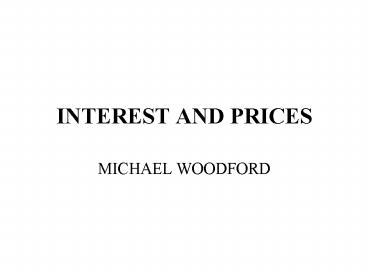INTEREST AND PRICES PowerPoint PPT Presentation
1 / 52
Title: INTEREST AND PRICES
1
INTEREST AND PRICES
- MICHAEL WOODFORD
2
MICROFOUNDED CAGAN-SARGENT PRICE LEVEL
DETERMINATION UNDER MONETARY TARGETING
FLEX-PRICE, COMPLETE-MARKETS MODEL
3
Complete Markets
Value of portfolio with payoff D
price kernel
4
Interest coefficient for riskless asset
Riskless Portfolio
5
Budget Constraint
Where T is the transfer payments based on
the seignorage profits of the central bank,
distributed in a lump sum to the representative
consumer
6
No Ponzi Games
For all states in t1
For all t, to prevent infinite c
The equivalent terminal condition
7
Lagrangian
8
Transversality condition
Flow budget constraint
9
Market Equilibrium
Market solution for the transfers T
10
Monetary Targeting BC chooses a path for M
Fiscal policy assumed to be
Equilibrium is
S.t. Euler-intertemporal condition condition FOC-i
tratemporal condition TVC Constraint
For given
11
We study equilibrium around a zero-shock steady
state
12
Derive the LM Curve
From the FOC
At the steady state
13
Separable utility
Define
The hat variables are proportional deviations
from the steady state variables.
14
Similar to Cagans semi-elasticity of money
demand
15
We log-linearize around
zero inflation
define
Log-linearize the Euler Equation and transform
it to a Fisher equation
Elasticity of intertemporal substitution
g is the twist in MRS between m and c
16
Add the identity
We look for solution given exogenous shocks
17
Solution of the system
This is a linear first-order stochastic
difference equation ,where,
Exogenous disturbance (composite of all shocks)
18
given
There exists a forward solution
From which we can get a unique equilibrium value
for the price level
This is similar to the Cagan-Sargent-wallace
formula for the price level, but with the
exception that the Lucas Critique is taken care
of and it allows welfare analysis.
19
I. Interest Rate Targeting based on exogenous
shocks
Choose the path for i specify fiscal policy
which targets D
Total end of period public sector liabilities.
Monetary policy affects the breakdown of D
between M and B
No multi-period bonds
Beginning of period value of outsranding bonds
End of period, one-period risk-less bonds
20
Steady state (around
)
fix
21
PRICE LEVEL IS INDETERMINATE
Real balances are unique
Future expected inflation is unique
Is unique
But, neither
Can uniquely be determined!
22
To see the indeterminancy, let denote
solution value
v is a shock, uncorrelated with (sunspot), the
new triple is also a solution, thus
Price level is indeterminate under the interest
rule!
23
II. Wicksellian Rules interest rate is a
function of endogenous variables (feedback rule)
Vcontrol error of CB
Fiscal Policy
Exogenous
Endogenous
24
Steady State
Log-linearize
25
We can find two processes
Add the identity
26
1), 2) and 3) yield
P is not correlated to the path of M money
demand shocks affect M, but do not affect P the
LM is not used in the derivation of the solution
to P.
27
FEATURES
- Forward looking
- Price is not a function of i rather , a function
of the feedback rule and the target - suppose
28
Additionally
- If
Price level instability can be reduced by raising
, an automatic response.
29
Note, also that
- Big
- Small
, reduces the need for accurate observation of
, almost complete peg of interest rate
30
The path of the money supply
By using LM, we can still express
But we must examine existence of a
well-defined demand for money. Theres possibly
liquidity trap
31
III. TAYLOR (feedback) RULE
- Steady state
Assume
32
Taylor principle
Is predetermined
33
Transitory fluctuations in
Create transitory fluctuations in
Permanent shifts in the price level P.
34
Optimizing models with nominal rigidities
- Chapter 3
35
(No Transcript)
36
(No Transcript)
37
First Order Conditions
38
Firms Optimization
Nominal
Real
39
Natural Level of Output
40
Log-linearization of real mc
Partial-equilibrium relationship?
41
where
Elasticity of marginal product of labor wrt output
Elasticity of wage demands, wrt to output
holding marginal utility of income constant
42
ONE-PERIOD NOMINAL RIDIGITY
Same as before, except for
Y need not be equal to the natural y
43
A Neo-Wicksellian Framework
THE IS
Ct consumption aggregate
gross rate of increase in the Dixit-Stiglitz
price index Pt
44
Equilibrium condition
A log-linear approximation around a deterministic
steady state yields the IS schedule
gcrowding out term due to fiscal shock
45
Effect on fiscal shock on C
Equivalent to the fiscal shock
46
New Keynesian Phillips Curve
Deviation of natural output due to supply shock
Demand determined output deviations
Taylor Rule
Inflation target
47
Output gap
3-EQUATION EQUILIBRIUM SYSTEM
Proportion of firm that prefix prices
IS-curve involves an exogenous disturbance term
48
INTEREST RULE AND PRICE STABILITY
THE NATURAL RATE OF INTEREST
49
Percentage deviation of the natural rate of
interest from its steady-state value
50
Inflation targeting at low, positive, inflation
Composite disturbances
51
(No Transcript)
52
Evolution of money supply
The only exogenous variables in the system are
the natural interest rate
nominal rate consistent with inflation target

